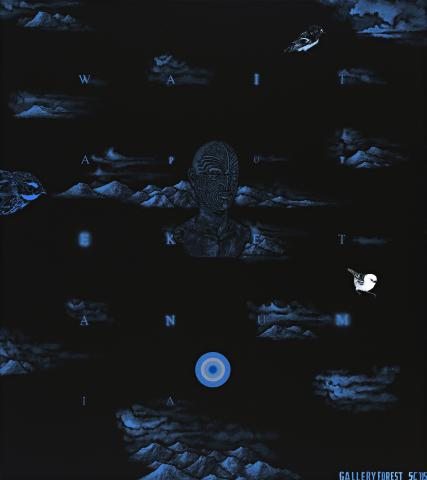GALLERY FOREST, 2005
SHANE COTTON
synthetic polymer paint on linen
180.0 x 160.0 cm
signed with initials, dated and inscribed with title lower right: GALLERY FOREST SC ‘05
Sherman Galleries, Sydney (stamped verso)
Gene and Brian Sherman collection, Sydney
2006 Contemporary Commonwealth, The Ian Potter Centre, National Gallery of Victoria, Melbourne, 24 February – 25 June 2006 (label attached verso)
Floating over deep ultramarine primordial waters, the bust of a Māori chief, resplendent with a full-faced moko (sacred Māori facial tattoos) occupies a central position in Shane Cotton’s allegorical painting, Gallery Forest, 2005. Surging forth from these opaque waters are also mountain ranges, slumbering volcanoes and ethereal wispy groups of cloud forms – the long white clouds of the artist’s native land, Aotearoa.
Widely regarded as Colin McCahon’s successor, Shane Cotton is a leading figure within the field of contemporary art in New Zealand and further afield. Strongly informed by contemporary post-colonial discourse and his own subjective experience, Cotton draws on mixed cultural heritage to create an artistic language that resonates with contemporary New Zealander audiences. By including traditional Māori iconography in his paintings, Cotton visually records the increasing resurgence of toi moko (sacred tattooing) amongst his contemporaries, signalling a reconnection with indigenous heritage and its hierarchical systems. The chief in this painting is not an anonymous icon. He is the controversial chief and war leader of the Ngāpui people, Hongi Hika (c.1772 – 1820), from whom the artist is descended.1 Cotton has inserted this portrait in his artwork, appropriated from a sketch from 1820 by Major General G. Robely, copied from a painted portrait created during the chief’s trip to Sydney and London between 1819 and 1821. Known primarily for his strength of character and the appreciation he had for European settlers and their missionaries, Hongi Hika was and is a controversial figure in the history of New Zealand, instrumental in shaping the cultural landscape of the nation. Cotton’s sparse allegorical composition attempts to deconstruct the complex cultural legacies Hika left for himself and his compatriots, offering not answers but more avenues for questions.
Gallery Forest was shown at Sherman Galleries in 2005, in an exhibition titled Pararaiha (meaning paradise), comprising of many large-scale canvases displaying the artist’s idiosyncratic aesthetic, slickly rendered with airbrushes rather than paintbrushes. Amongst the landscape paintings and op-art inspired target paintings, were four paintings featuring portraits of Hongi Hika. One of these paintings was based on his carved portrait held in the permanent collections of the University of Sydney Museums,2 and later acquired by Auckland Art Gallery Toi o Tāmaki. Adorning Gallery Forest’s portrait of Hika are striking renditions of native and exotic birds, as well as individual letters of the alphabet, creating an overall effect that is enigmatic and diagrammatic. Painted in striking iridescent blue paint, Cotton’s images seem disparate, drawn from Christian iconography as well as ancient Māori scripture. The predominance of blue in the works of the Pararaiha exhibition reflect the Māori word for blue, kikorangi, which was used in indigenous translations of the Bible to refer to the heavens, etymologically constructed from the words flesh and sky.3 Creating syncretic syntax to serve as a symbol of hope for future generations, Cotton provides stimuli for future investigations of national identity, promoting the wealth of Māori heritage, as the title of his exhibition in 2005 proudly suggested.
1. Mason, N., Pararaiha, exhibition text, Sherman Galleries, Sydney, 2005
2. ‘AOTEAROA - NEW ZEALAND COLLECTION’, Sydney University Museums, viewed 11 April 2017 http://sydney.edu.au/museums/collections/aotearoa.shtml
3. Murray-Cree, L., ‘Shane Cotton. Identity and Transformation’, Art World, Issue 4, August – September 2008, p. 131
LUCIE REEVES-SMITH
